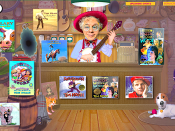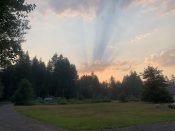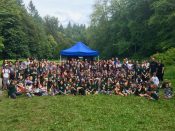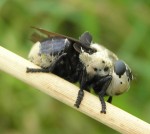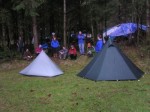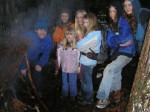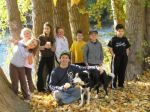2010.09.03 – Study Site (& bald-faced hornets) Found!
I saw the slug. It was surrounded by carpenter ants and I wondered why they would go after a slug. Was it for food? Should I save it? Wouldn’t the slugs natural slime defense protect it from them? Was the slug considered an invader for some reason?
As I squatted under the willow for a closer look I realized that they weren’t really interacting with one another other than happening to cross paths. By the number of ants around I figured this must be near their home or on one of their major travel routes. The slug was turning, tentacles at full extension, and moving slowly (or was it quickly) on its way. As I watched the ants move in what seemed a completely chaotic manner it dawned on me that there was a lot (by that I mean an alarming amount) of buzzing going on in my immediate vicinity. As I slowly raised my eyes I saw hundreds (ok, more like 15, but it sounded like hundreds) of bald-faced hornets (Dolichovespula maculate) flying all around me. Now I don’t know how most people would feel, but having walked into an angry swarm of disturbed ground-nesting yellow-jackets in my time I was freaking out just a little. Should I move? Can they sense fear? How did I not notice this before squatting right in the middle of it?! Take a deep breath. As I sat, I realized they didn’t mind me at all – they were busy on a mission of their own. And, I had found my study site.
The ants were farming aphids for their honeydew and the hornets (and yellow jackets too!) were hunting the aphids and gathering the honeydew that was falling from the aphids onto the willow leaves and grass below. I stepped back a dozen feet and watched through my binoculars as the hornets landed on the leaves and grass and collected.
They definitely don’t like other hornets in their vicinity because they would attack others as they got near. They’d tumble together to the ground then fly off to different parts of the tree and do it all again. I checked out the other willows in the area but this was the only one with the aphids, ants and hornets. I wonder which came first, the ants or the aphids. Was this particular tree weaker than the rest? Did the aphids take advantage of that weakness and eventually the ants found them and began farming? Or, did the ants do something to weaken the tree which brought aphids for them to farm. Or, did the ants bring the aphids from somewhere else and put them there? Whatever the answer, the ants were definitely defending the aphids. I watched a hornet fly up to grab an aphid and an ant run down to confront it. The hornet dove toward the ant, the ant reared up at it and the hornet flew crazily away. Not sure if they ever actually made contact or not but it sure was amazing to watch.
Earlier in the week I found the actual bald-faced hornet hive in the tall grass a few yards off our driveway. Fortunately I hadn’t thrown our dog’s ball over there for her to find. What a find that would’ve been! My first thought was to destroy it (I know, pretty awful right). But stinging insects are scary things since they, ya know, sting. And the baldies are gigantic which makes them even more intimidating. So I jumped online and googled the many ways to take care of the problem – hire an exterminator, come in under cover of dark and spray the nest hole from a distance with toxic chemicals then run, hook up the shop-vac and suck them all in along with some Raid. Then I read that bald-faced hornets (not really hornets by the way) are actually only aggressive when their hive is attacked. Otherwise they’re just going about their business foraging for other yard insects and nectar and occasionally pollinating flowers. So, I decided to leave the hive alone. I watched them every time I went by and wondered where they all went. Well, now I know at least one of the places – to the willow in my study site.
It was getting late but the baldies were still after the aphids and honeydew. I went inside for the night but could hardly wait until the next morning to head out again to observe and explore. 1930, 60 degrees, mostly clear with a few scattered clouds
2101.09.04 – Study Site Explored
I was so excited to head out and explore my site this morning. I was not disappointed. Right off the bat I found a spider carrying her egg sac beneath her abdomen. I suppose that beats carrying the live babies on her back, though some spiders do just that.
Then, binoculars and camera in hand, I cut through the garden and jumped the split-rail fence near the “hornet willow” as it’s now affectionately called. Sure enough, the critters were out there buzzing around, harassing the ants and collecting honeydew. I watched for about 20 minutes then decided it was time to explore a bit, see what I could find and choose my site boundaries. My site is in my backyard and the wetland beyond.
The west side of the site begins just behind the garage. There’s a row of small trees that create an edge between the building and the grasses of the wetland. Continuing east past the building, the yard opens up to some blueberry bushes and apple trees and a large expanse of lawn with a straw bale garden right in the middle just prior to the house – my south boundary.
On the north side is the open grass of the wetland interspersed with some plantings (including the hornet willow), snags and coarse woody debris (cwd). There is a split rail fence that divides my yard from the wetland running through the center of my site from west to east. The eastern boundary has yet to be determined. It could run as far as out to the road or I may decide there’s enough going on and the area is large enough and end it just east of the house. We’ll see.
As I wandered the area I found and photographed several insect species, an owl pellet beneath a snag, some rabbit fur beneath another snag, raccoon scat with plum pits, common yellowthroats and song sparrows and many kinds of plants and trees.
As I was heading out of the area to return to the house I noticed a huge bumblebee sitting on a stalk of tall dry grass. Figuring I’d better take a photo of it, I approached with my camera ready. As I got closer it looked less and less like a bumble bee and more like some sort of a cross between a bee and a giant fly. I snapped a picture and it took off with a loud buzz. I had never seen anything like it in all my years running around in the woods.
There’s a really great website I’ve perused many times called bugguide.net. There you can look through thousands of pictures of insects and even send in photos to be identified. Since I had a UFI (unidentified flying insect) I created a user name and password and sent my picture. Within hours I learned I had found a botfly!! I am still so excited about that awesome find. Turns out this little critter lays its eggs on deer mice (not humans, dogs or cats thank goodness!). And my photo was the first they had received of one. Unfortunately they couldn’t tell the sex because I only had a side shot. Nonetheless I was thrilled and really enjoyed telling my family and friends that I had a botfly in my yard. If you want to check out my picture and more information on bugguide, go to http://bugguide.net/node/view/451527 . So, I’ve started an Excel spreadsheet to list out the plants and animals I find in my area. Next will come the mapping. 1000, 55 degrees, mostly cloudy but bright
2010.09.12 – Study Site Visited (but not by me)
It was about 2am and I was up working on a project. All of a sudden the still night air erupted with coyote howls. I jumped up from the table and ran to the window. It was so dark I couldn’t see a thing but there were at least 2 coyotes in my study site (less than 50 feet away) calling to a 3rd that was further to the west. Their yipping and howling was piercing. I listened intently as they continued for at least a minute. I wondered whether they found a prey item, were responding to a distant siren or were just communicating their location to another of their pack. They stopped as quickly as they had started and the night silence returned. 0200, 50 degrees, cloudy

